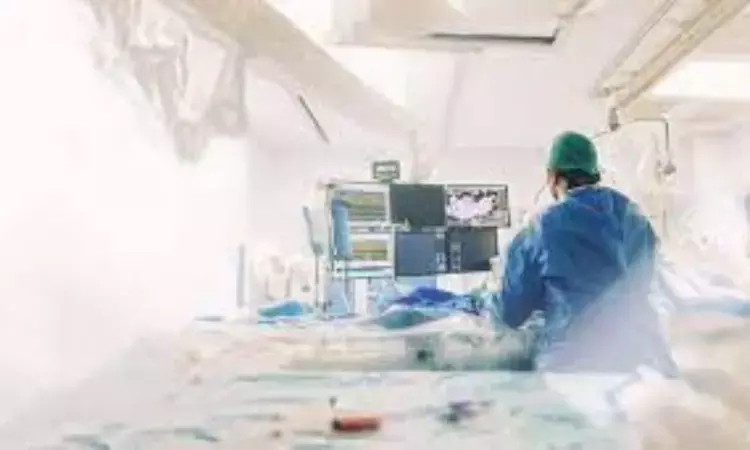- Home
- Medical news & Guidelines
- Anesthesiology
- Cardiology and CTVS
- Critical Care
- Dentistry
- Dermatology
- Diabetes and Endocrinology
- ENT
- Gastroenterology
- Medicine
- Nephrology
- Neurology
- Obstretics-Gynaecology
- Oncology
- Ophthalmology
- Orthopaedics
- Pediatrics-Neonatology
- Psychiatry
- Pulmonology
- Radiology
- Surgery
- Urology
- Laboratory Medicine
- Diet
- Nursing
- Paramedical
- Physiotherapy
- Health news
- Fact Check
- Bone Health Fact Check
- Brain Health Fact Check
- Cancer Related Fact Check
- Child Care Fact Check
- Dental and oral health fact check
- Diabetes and metabolic health fact check
- Diet and Nutrition Fact Check
- Eye and ENT Care Fact Check
- Fitness fact check
- Gut health fact check
- Heart health fact check
- Kidney health fact check
- Medical education fact check
- Men's health fact check
- Respiratory fact check
- Skin and hair care fact check
- Vaccine and Immunization fact check
- Women's health fact check
- AYUSH
- State News
- Andaman and Nicobar Islands
- Andhra Pradesh
- Arunachal Pradesh
- Assam
- Bihar
- Chandigarh
- Chattisgarh
- Dadra and Nagar Haveli
- Daman and Diu
- Delhi
- Goa
- Gujarat
- Haryana
- Himachal Pradesh
- Jammu & Kashmir
- Jharkhand
- Karnataka
- Kerala
- Ladakh
- Lakshadweep
- Madhya Pradesh
- Maharashtra
- Manipur
- Meghalaya
- Mizoram
- Nagaland
- Odisha
- Puducherry
- Punjab
- Rajasthan
- Sikkim
- Tamil Nadu
- Telangana
- Tripura
- Uttar Pradesh
- Uttrakhand
- West Bengal
- Medical Education
- Industry
High-frequency, low-tidal-volume ventilation tied to catheter ablation success for atrial fibrillation: JACC

USA: High-frequency, low-tidal-volume (HFLTV) ventilation during catheter ablation of paroxysmal atrial fibrillation (PAF) improves 12-month clinical outcomes, as shown by registry data across 12 institutions.
Following implementing HFLTV ventilation during the procedure, the researchers observed freedom from all-atrial arrhythmia recurrence, AF-related symptoms, and atrial fibrillation-related hospitalizations with shorter procedural times. The findings from the study were published in JACC: Clinical Electrophysiology.
High-frequency, low-tidal volume is a simple and safe strategy to improve first-pass isolation and catheter stability during pulmonary vein (PV) isolation. However, the impact of this technique on long-term clinical outcomes has yet to be investigated. Therefore, Jose Osorio, Arrhythmia Institute at Grandview, Birmingham, Alabama, USA, and colleagues sought to evaluate acute and long-term outcomes of HFLTV ventilation compared with standard ventilation (SV) during radiofrequency (RF) ablation of paroxysmal atrial fibrillation.
A standard ventilation protocol typically employs high tidal volumes with low respiratory rates during catheter ablation. In contrast, HFLTV ventilation minimizes the downward shift of the diaphragm during inspiration, which may improve catheter stability and boosts first-pass isolation during pulmonary vein isolation (PVI).
The prospective multicenter registry (REAL-AF) included patients undergoing PAF ablation using standard ventilation or HFLTV. The study's primary outcome was 12 months of freedom from all-atrial arrhythmia. Secondary outcomes were AF-related symptoms, procedural characteristics, and hospitalizations at 12 months.
The study revealed the following findings:
- A total of 661 patients were included. Compared with those in the SV group, patients in the HFLTV group had shorter procedural (66 minutes versus 80 minutes), total RF (13.5 minutes versus 19.9 minutes), and PV RF (11.1 minutes versus 15.3 minutes) times.
- First-pass PV isolation was higher in the HFLTV group (66.6% vs 63.8%).
- At 12 months, 85.6% of patients in the HFLTV group were free from all-atrial arrhythmia, compared with 79.3% of patients in the SV group.
- HLTV was associated with a 6.3% absolute reduction in all-atrial arrhythmia recurrence, a lower rate of AF-related symptoms (12.5% versus 18.9%), and hospitalizations (1.4% versus 4.7%).
- There was no significant difference in the rate of complications.
"HFLTV ventilation during catheter ablation of paroxysmal atrial fibrillation improved freedom from all-atrial arrhythmia recurrence, atrial fibrillation-related symptoms, and AF-related hospitalizations with shorter procedural times," the researchers wrote.
"Future research may compare HFLTV ventilation with high-frequency jet ventilation, which is also anticipated to increase catheter stability -- albeit with costly special equipment," they concluded.
Reference:
Osorio J, Zei PC, Díaz JC, Varley AL, Morales GX, Silverstein JR, Oza SR, D'Souza B, Singh D, Moretta A, Metzl MD, Hoyos C, Matos CD, Rivera E, Magnano A, Salam T, Nazari J, Thorne C, Costea A, Thosani A, Rajendra A, Romero JE. High-Frequency Low-Tidal-Volume Ventilation Improves Long-Term Outcomes in Atrial Fibrillation Ablation: A Multicenter Prospective Study. JACC Clin Electrophysiol. 2023 May 18:S2405-500X(23)00298-0. doi: 10.1016/j.jacep.2023.05.015. Epub ahead of print. PMID: 37294263.
Dr Kamal Kant Kohli-MBBS, DTCD- a chest specialist with more than 30 years of practice and a flair for writing clinical articles, Dr Kamal Kant Kohli joined Medical Dialogues as a Chief Editor of Medical News. Besides writing articles, as an editor, he proofreads and verifies all the medical content published on Medical Dialogues including those coming from journals, studies,medical conferences,guidelines etc. Email: drkohli@medicaldialogues.in. Contact no. 011-43720751


